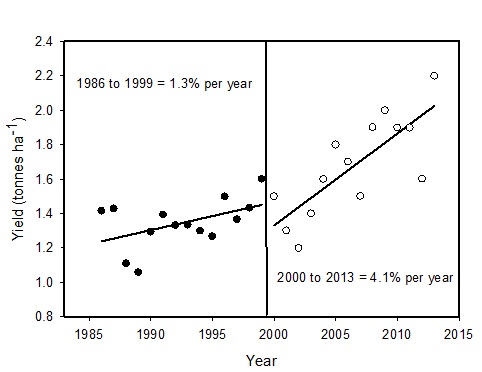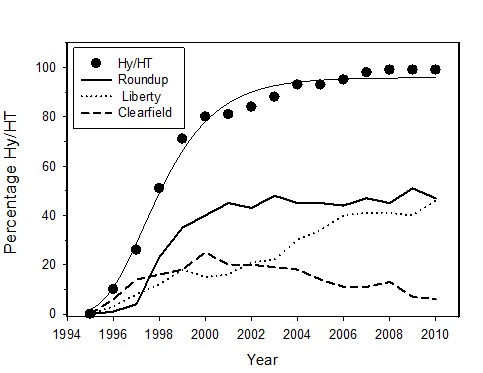Innovations underpinning yield improvements in the Canadian canola industry
Author: Malcolm Morrison, Bob Blackshaw, John O’Donovan, Neil Harker and Chris Holzapfel (Eastern Cereal and Oilseed Research Centre, Agriculture and AgriFood Canada) | Date: 10 Feb 2015
Take home messages
- Canadian prairie farmer canola yield increased by 695 kgha-1 from 2000 to 2013, representing an increase of more than 50%.
- The yield increase was due primarily to the adoption of hybrid varieties with herbicide tolerance (over half the yield increase), with other factors including the increase in spring precipitation and seasonal CO2 concentration, and the use of solid management practices.
- New hybrids with herbicide tolerance must be accompanied with new agronomy.
Background
Canola is Canada’s second largest crop in production following wheat with over eight million hectares seeded in 2014. Driven by high price and strong world demand, production has increased from 3,900 tonnes in 1986 to nearly 18,000 tonnes in 2013. The majority of canola production occurs on the Great Plains or Prairie provinces of Saskatchewan, Alberta and Manitoba. Prairie farmer canola yields increased by 65% from 1986 to 2013 with the majority of the yield improvements occurring after 2000 (Figure 1). From 2000 to 2013, Prairie farmer canola yields have increased by 695 kgha-1 or 54 kgha-1 per year; which is an increase of 53 % or 4.1% per year.

Figure 1. Prairie canola farmer yield (tonnes ha-1) from 1986 to 2013 (Source: Statistics Canada).
The increase in Prairie farmer canola yield during the first part of this century has largely been the result of the adoption of hybrid canola with herbicide tolerance (HY/HT, Figure 2). Today over 95% of the canola varieties grown are HY/HT. The yield gain from the adoption of new varieties of canola was estimated from the Prairie Canola Variety Performance trials to be ~2.4% per year, accounting for about 32 of the 54 kgha-1 per year increase. When surveyed, farmers indicated that herbicide tolerant canola was a must with zero tillage systems, reduced the cost of production, increased yields and reduced dockage charges, and enabled volunteer canola plants to be easily cleaned-up in the rotation year. Farmers were concerned about the potential for herbicide tolerant weeds and that export to some nations may be blocked. The adoption of HY/HT varieties has not affected export sales of canola.

Figure 2. The adoption of canola hybrids with herbicide tolerance (HY/HT) (Source: Canola Council of Canada).
Another reason for canola yields increasing on the Canadian Prairies has been the increase in spring precipitation. From 2000 to 2013 precipitation during the months of April and May increased by four millimetre per year resulting in 16 of the 54 kgha-1 per year yield increase. Atmospheric carbon dioxide (CO2), used by plants in photosynthesis, has increased by 25 ppm since 2000. Experiments have found that canola yields increase by ~1.7 kgha-1 per ppm CO2, and therefore, about three of the 54kgha-1 increase was due to CO2.
When the balance sheet of 54 kgha-1 per year increase was totalled, 32 kg was due to improved genetics and 19 kg due to precipitation and CO2 (environment), leaving 3 kg attributed to management practices. This may seem like a low number but it must be remembered that many of the best management practices such as tillage method, seed treatments, planting, fertilising, and harvesting methods may have been perfected prior to 2000, and therefore, are already being practiced.
New HY/HT varieties may need new management practices in order to achieve their full yield potential. Experiments have shown that HY/HT varieties will respond to higher nitrogen fertiliser than older OP ones, but they may not necessarily be more nitrogen use efficient. Tests done on farmer’s canola fields with variable rate N application based on sensor technology, have shown that variable rate N application can successfully improve the economic bottom line. While ~70% of prairie farmers only use a two year cereal-canola rotation, research has shown that yields improve with a three year rotation that includes a legume, due to reduced disease pressure and lower N demand.
Seed costs are the second highest input cost after fertiliser. Even with a high germination rate seed, only 50 to 60 % emerge above the soil surface. Screening hybrid seed lots for larger seed size did not increase emergence or yield, although biomass and weed competition was greater. On average, a plant population of 80 plants m-2, achieved with a seeding rate of ~150 seeds m-2offered the best opportunity for high yield in the Prairie environment.
Conclusion
The large improvement in canola yield over the past 14 years has been due to improved hybrid varieties with herbicide tolerance. Higher spring moisture has also added to the yield improvement. In future, management practices may need to be tailored to new varieties.
Contact details
Malcolm MorrisonEastern Cereal and Oilseed Research Centre, Agriculture and AgriFood Canada
960 Carling Ave, Ottawa, ON, Canada, K1A 0C6
01-613-759-1556
Was this page helpful?
YOUR FEEDBACK
